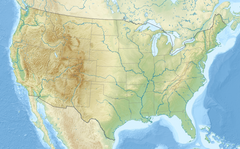| Dragon Peak | |
|---|---|
 Northwest aspect | |
| Highest point | |
| Elevation | 12,955 ft (3,949 m) [1] [2] |
| Prominence | 296 ft (90 m) [3] |
| Parent peak | Mount Gould (13,011 ft) [4] |
| Isolation | 0.75 mi (1.21 km) [4] |
| Listing | Sierra Peaks Section Vagmarken Club Sierra Crest List [5] |
| Coordinates | 36°47′23″N118°22′33″W / 36.7898467°N 118.3758937°W [6] |
| Geography | |
| Location |
|
| Parent range | Sierra Nevada |
| Topo map | USGS Mount Clarence King |
| Geology | |
| Mountain type | Fault block |
| Rock type | Metamorphic rock [7] |
| Climbing | |
| First ascent | 1920 |
| Easiest route | class 4 scrambling [4] |
Dragon Peak is a 12,955-foot-elevation (3,949-meter) mountain summit located on the crest of the Sierra Nevada mountain range in northern California. [6] It is situated on the common border of Fresno County with Inyo County, as well as the boundary shared by John Muir Wilderness and Kings Canyon National Park. It is 10 miles (16 km) west of the community of Independence, and 1.3 miles (2.1 km) south of Black Mountain. Dragon Peak ranks as the 161st-highest summit in California. [4] Topographic relief is significant as the north aspect rises 1,900 feet (580 meters) above Dragon Lake in less than one mile. This mountain is habitat for the endangered Sierra Nevada bighorn sheep, which restricts climbing from July through December, so most ascents are made in the spring. The first ascent of the summit was made in 1920 by either Norman Clyde, or Fred Parker and J. E. Rother. [8] The John Muir Trail traverses two miles west of this peak, providing an approach option. The mountain is so named because of the shape of its outline as seen from Rae Lakes. [9]


